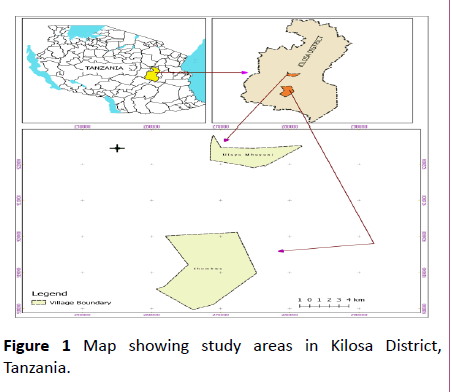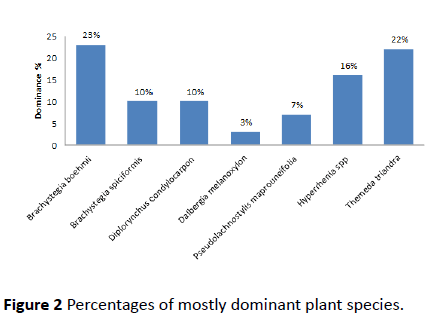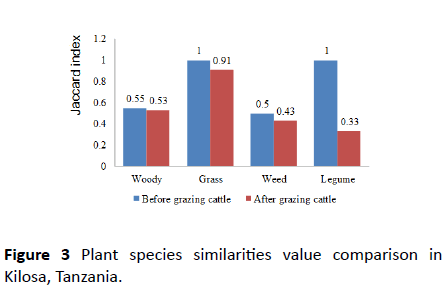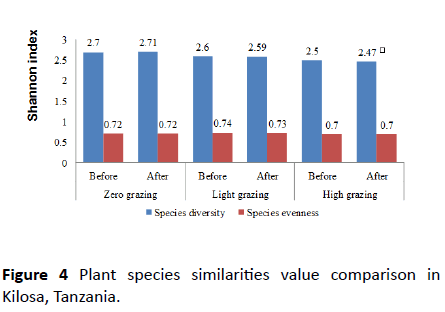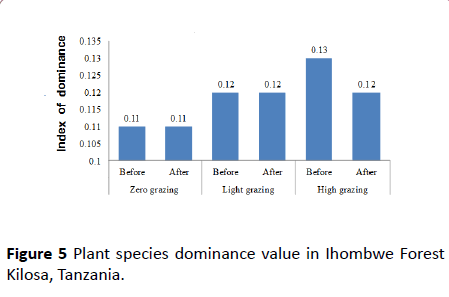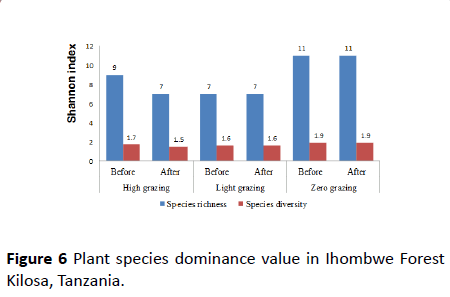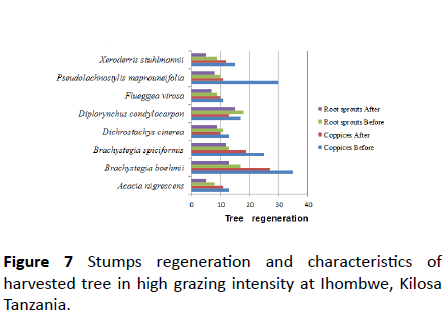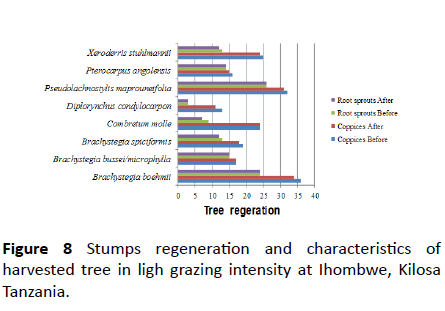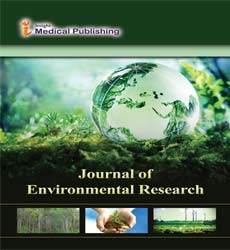Ecological Effects of Cattle Grazing on Miombo Tree Species Regeneration and Diversity in Central-Eastern Tanzania
John R Mtimbanjayo1 and Anthony Z Sangeda2*
1Department of Forest and Environmental Economics, Sokoine University of Agriculture (SUA), Morogoro, Tanzania
2Department of Animal, Aquaculture and Range Sciences, Sokoine University of Agriculture (SUA), Morogoro, Tanzania
- *Corresponding Author:
- Anthony Z. Sangeda
Department of Animal, Aquaculture and Range Sciences, Sokoine University of Agriculture (SUA), Morogoro, Tanzania
Tel: +255 784541833
E-mail: sangedaaz@gmail.com
Received date: January 12, 2018; Accepted date: March 07, 2018; Published date: March 12, 2018
Citation: Mtimbanjayo JR, Sangeda AZ (2018) Ecological Effects of Cattle Grazing on Miombo Tree Species Regeneration and Diversity in Central-Eastern Tanzania. J Environ Res Vol.2: No.1: 3.
Abstract
The inspiration of this study is to determine the effects of cattle grazing on tree species composition and regeneration in Miombo ecosystem of Eastern Tanzania. The study was done in wet season for three months. The effects were assessed in three different levels of grazing intensity. Cattle grazing intensities namely zero (no grazing), light and high of 50 m × 50 m plot size with ten replications for each level were established. Results revealed that, in high cattle grazing intensity there was a significance decrease of plant species composition, seedling regeneration, plant coppices and root sprouts. High intensity cattle grazing have significant ecological effects in Miombo woodlands while light grazing intensity had no effects. Grazing larger heads of cattle in Miombo should be avoided for sustainability of ecological services. However, ecological services can be maintained under controlled grazing. Therefore, grazing of cattle can be allowed in specific season of the year especially during dry seasons to rescue massive death of livestock. Further research on the effects of browsing animals should be done in Miombo ecosystems because most grazing herds combine both grazer and browser animals.
Keywords
Cattle grazing effects; Miombo ecosystem; Tree regeneration; Grazing intensity; Kilosa; Tanzania
Introduction
Kilosa District is potential for grazing but is associated with land scarcity due to limited land size [1]. Most of its remaining land is reserved Miombo in which grazing is not allowed by law and the available limited grazing areas have been progressively lost, have poor cattle carrying capacity and poor forage yield something that increases grazing pressure to protected areas, mainly Forest Reserves and National Parks [2].
Factors that contribute to land scarcity and limited grazing areas are existence of estate farms for sisal, large research farms, several agricultural irrigation schemes, sugarcane plantation, mining areas, protected areas including Forest Reserves, Mikumi National Park, Selous Game Reserve, Kilombero Game Controlled Area and competitive land uses such as established Wildlife Management Area, hunting blocks and buffer zones [3]. Grazing is strictly prohibited in these areas through Tanzania Wildlife Act No. 5 (2009), Forest Act No. 14 (2002), Energy and Mineral Act No. 10 (2010), Village Land Act No. 5 (1999) and many more.
Despite of these legislations, some pastoral districts in Tanzania (e.g in Manyara region) have declared (through village Bylaws) to allow livestock grazing in reserved areas during critical dry season to serve massive death of livestock. However, this illegal practice is done without knowledge on ecological effects that may be caused by cattle grazing. This study therefore aims at bridging this gap by assessing effects caused by cattle grazing on species composition, diversity and regeneration of Miombo tree species in Kilosa Tanzania. Findings of this study will be useful in informing policy on sustainable management strategies in Miombo ecosystems that are the largest share of forest vegetation in the country [4].
Methodology
Study area
The study was carried out in Kilosa District, Morogoro region, Central-East Tanzania (5°55'-7°53'S and 36°30'-37°30' E). Kilosa District (Figure 1) has tropical climate with the mean annual temperature of 25°C.
It has binomial rain fall which split between the short rains in November to January and the long rains between March to June which range from 800 mm to 1300 mm in the low and high-altitude areas respectively. This ecosystem is mainly endowed with both natural forests and woodlands. Woodlands and forest cover about 40% of the total land area [2]. The current coverage of central government forest reserves is about 97,700 ha managed by the Tanzania Forest Services.
District Council Forest Reserves cover an area of 24,654 ha. Mikumi National Park overlaps with about 212,500 ha of the district and the area under Village Land Forest Reserves is about 124,335 ha [1].
Study design
Ihombwe village was randomly selected out of the eight villages that are under a project managed by two NGOs called MJUMITA and Tanzania Forest Conservation Group (TFCG). Three cattle grazing intensities (zero, light and high) of 50 m × 50 m plot size with ten replications for each were established. Plant species composition was determined by using concentric radius method and physical observations before and after grazing to assess the effects of cattle in 30 wire fenced plots. Zero grazing intensity (10 plots) was used as control. Ten plots of light grazing intensity were grazed with 10 cattle/0.25 ha/day whilst the rest ten plots of high grazing intensity were grazed with 20 cattle/0.25 ha/day. Cattle selected for grazing were of the same conditions. The experiment was done during wet season for three months. Grazing time per day was five hours using experienced livestock keepers.
Data collection
The vegetation survey was conducted at pre and post cattle grazing. Circular sample plots design was used as adopted from several small scale inventories carried out in Tanzania [5]. The plant species were identified in every 2 m radius within the sample plot size of 50 m × 50 m. Plant species were measured and identified to species level whilst tree with height ≥ 1 cm, coppices and root sprouts were marked by color, measured, monitored and identified to species level.
Variables recorded in each plot included; botanical names, local names, number of stems, stems height, number of stumps, seedlings, coppices and root sprouts. Botanical identification was done in the field using a botanist and competent local tree identifier.
Cattle effects were assessed by comparing variation of plant species composition, diversity, similarity, seedlings, coppices and root sprouts status. Also disturbance assessment was assessed through counting the number of damaged plants, coppices, root sprout, introduced invasive species in each inventory plot after cattle grazing.
Data analysis
Plant species composition, diversity, richness, evenness, species dominance within the plots were assessed based on the Shannon-wiener index of diversity (H’), Simpson index (SI) and Jaccard index of similarity (JI). The data were analyzed by using Microsoft Excel Program using the following formulas.
Where ID=Index of dominance, ni=Number of individuals of species i in the plot, N=Total number of individuals of all species in the plot
Where, JI=Jaccard index of similarity, j=the number of species common to the sites and tenure types, n1 and n2=the number of species occurring in site 1 and site 2, respectively.
Results and Discussion
Plant species composition
Results in Table 1 shows that, there were forty six (46) plant species identified within 30 wire fenced plots at Ihombwe forest. After grazing cattle, there were forty seven (47) plant species identified in the plots. Black jack spp (weed) was observed in high grazing intensity after end of grazing rotation period. For both situation (before and after grazing) plant species Brachystegia boehmii, Brachystegia bussei/ microphylla, Brachystegia spiciformis, Hyperrhenia spp, Themeda triandra and Pseudolachnostylis maprouneifolia were dominant. The identified Miombo species are almost similar to those reported by Nduwamungu [6], Sangeda and Maleko [7] in Kilosa District. The most frequently encountered species in Miombo woodlands were Brachystegia boehmii and Brachystegia spiciformis.
| Woody | Grass | Weed | Legume |
|---|---|---|---|
| Acacia nigrescens | Aristida spp | Amaranthas spp | Crotalaria spp |
| Acacia macrothyrsa | Bothrochloa spp | Borhavia difusa | Neorautanenia spp |
| Acacia Senegal | Chloris spp | Sida spp | Rynchosia spp |
| Annona spp | Cynodon spp | Solanum spp | - |
| Afzelia quanzensis | Digitaria spp | Oxigonum spp | - |
| Albizia versicolor | Echinochloa spp | Cyperus spp | - |
| Brachystegia boehmii | Heteropogon spp | Black jack spp | - |
| Brachystegia bussei/microphylla | Hyperrhenia spp | - | - |
| Brachystegia spiciformis | Themeda triandra | - | - |
| Buckea Africana | Urochloa spp | - | - |
| Combretum molle | Panicum spp | - | - |
| Combretum zeyhen | - | - | - |
| Combretum/Terminalia spp | - | - | - |
| Dalbergia melanoxylon | - | - | - |
| Diplorynchus condylocarpon | - | - | - |
| Dichrostachys cinerea | - | - | - |
| Faidherbia albida | - | - | - |
| Flueggea virosa | - | - | - |
| Pseudolachnostylis maprouneifolia | - | - | - |
| Pterocarpus angolensis | - | - | - |
| Sclerocarya birrea | - | - | - |
| Xeroderris stuhlmannii | - | - | - |
| Sterculia quinqueloba | - | - | - |
| Markhamia spp | - | - | - |
| Swartzia (Bobgunnia) madagascarien | - | - | - |
| Terminalia sericea | - | - | - |
Table 1: Plant species compositions in Ihombwe Forest, Kilosa Tanzania.
Other species such as Albizia versicolor, Fluggea virosa, Millettia spp, Terminalia sericea, Markhamia spp, Swartzia (Bobgunnia) madagascariensis, Cyperus spp and Annona spp appeared once in each plot despite of being in the same ecological zone where rainfall pattern and edaphic factors are almost the same. This variation is presumably linked to existence of different level of disturbance in the forest. Luoga [8] argue that among the factors associated with the variation in species composition and richness in Miombo woodlands is disturbances, especially when edaphic factors are similar. Furthermore, Munishi [9] argue that sparse distribution of some species may be an indication of natural phenomena (species having restricted range), outlines species population outside their normal range or may represent species at state of decline or as results of human impacts and utilization pressure.
Further results (Figure 2) shows typical situations where the preferred timber plants were no longer available. During key informant discussion, 83% reported that, most of plant species have medicinal values and therefore harvested. Similar study by Shangali et al. [10] reported that in Udzungwa forest trees are mostly harvested for traditional medicine use.
Plant species similarities
Figure 3 shows similarity value of plots before cattle grazing ranging from 0.5-1. This was a high value probably due to the fact that the experimental area was relatively undisturbed. Secondly, it might be due to the abandonment of farming activities by the peasants and that led to successional changes [11] and introduction of Participatory Forest Management through Community Based Forest Management [12]. Contribution of grass such as Urochloa, Themeda triandra, Hyperrhenia, Echinochloa, Cynodon, Chloris, Digitaria and Heteropogon species and weeds on ground cover was higher before grazing cattle in all grazing intensities. Frequent burning practices, charcoal making and other human disturbances made favorable condition for these grasses and weed species to germinate very quickly as their seeds were scarified by fire.
After cattle grazing, the high grazing intensity plots were mostly dominated by weed species where grasses were dominant all over the plots. New weed specie (Black jack spp) was observed after cattle grazing in the high grazing intensity plots.
The most frequently occurring invader plant species were; Amaranthas, Cyperus, Oxigonum, Solanum, and Sida species. Similar study by Kigomo [13] reported that when the grazing areas are excessively overused, usually invaders and other undesirable plants increased. Compared to the proportion of the species identified, grasses were observed in low frequency after grazing.
This might be due to the gradual disappearance of desirable species through overuse and disturbance by cattle. Changes are induced in the dominant growth forms of herbaceous plants as tall perennial bunch grass species give away to shorter rhizomatous and stoloniferous perennial grasses which are replaced by annual grass and forbs.
Moreover, overgrazing changed the botanical composition of the plants as it tends to reduce perennial grassland vegetation and allow invasion by annual forbs and grasses.
Likewise, few leguminous plant species were found in the high grazing intensity plots. The legume plant species with higher frequency in the grazing areas were; Neorautanenia, Rynchosia and Crotalaria species.
According to the livestock keepers, the leguminous plant species are among the highly desirable species which were highly preferred by the animals. The reduction in the proportion and disappearance of Neorautanenia and Crotalaria species as highly desirable species might be due to their gradual disappearance through overuse by livestock.
The results were in agreement with those of Kigomo [13] who reported that highly desirable species were highly palatable and preferred by livestock which resulted into decline in number with increasing grazing pressure.
Plant species diversity, richness and evenness
The stability of any community is directly dependent on the diversity. The higher values of diversity indicate greater stability of community structure. Shannon Wiener diversity index in all grazing intensities ranges from 2.47–2.71 (Figure 4). This implies that the plant species diversity is normal. The obtained results are within the good diversity range of 1.5 and 3.5 recommended by Kent et al. [14]. The good plant species diversity can be used to justify the good effort in conservation activities. Comparable results by Mafupa [15] shows that Shannon Winner index value was of 2.4 in Miombo Forest in Tabora Tanzania.
A study by Isango [16] further reported that the Kitulangalo Forest Reserve had 57 different tree species in 2002 while in 2005 the species recorded increased to 60. A study by Backeus et al. [17] reported 86 Miombo woodland tree species around Ihombwe, Kilosa District, Tanzania. The variations in the numbers of tree species within and between forest sites could be contributed by differences and changes in climatic conditions like variations in rainfall and temperature, variations in soil types, and varying levels of disturbances (deforestation, wildfires, grazing) in those forest reserves. Similar study by Sangeda and Maleko [7] reported that tree harvesting reduces species diversity.
Species dominance
Results in Figure 5 reveals that the average species dominance based on Simpson’s index before cattle grazing were higher in high grazing plots. The dominance index observed in zero grazing intensity implies that, the probability of picking randomly two individuals belonging to the same species is very low compared to light and high grazing intensities. These values are low suggesting that, there is low dominance of plant species in the study area. This again suggests that plant communities studied are less diverse in species. Similar study reported less ID value of 0.043 and 0.063 for Miombo woodlands forest in Handeni District, Eastern Tanzania [18]. Comparing the situation before and after cattle grazing, there were a slight change of dominance value in high grazing intensity and no change of dominance value in light grazing intensity plots. This might be due to damaged plants by cattle during grazing.
Tree seedling richness and diversity
Results in Figure 6 shows that, the diversity of regenerating tree species was slightly lower. Diversity index value of regenerating species was higher in zero grazing intensity compared to light and high grazing intensities before cattle grazing.
Furthermore, regeneration of seedlings was observed to be poor in those areas dominated by tall grass species that were too dense. Dominant grass species in those plots were Themeda triandra and Hyparrhenia spp. After cattle grazing, diversity of regenerating tree species, number of individual plants and plant species richness decreased in all grazing intensities compared to before cattle grazing. During plots assessment, some of the seedlings especially with less than one-meter height (seedling<1 m) were observed damaged after cattle grazing that’s why there were changes in number of individual plants species, plant species richness and diversity of plant after cattle grazing. Similar results were also reported by Sangeda and Maleko [7] in the Sustainable Charcoal Project sites in Kilosa District. They noted low diversity of regenerating seedlings to be caused by several factors including fire, seed dormancy and grazing.
Tree stumps regeneration
Figure 7 shows that, there were 181 stumps that were identified in all three grazing intensities. The identified tree stumps are those left following tree harvesting for charcoal making.
There were no grazing intensity plots without at least one stump that was sprouting and/or coppicing The most frequently harvested tree species for charcoal making were Brachystegia boehmii (43.1%), Brachystegia spiciformis (23.2%), Diplorynchus condylocarpon (11.6%), Pseudolachnostylis maprouneifolia (14.4), Combretum molle (0.6%), Combretum/Terminalia spp (0.6%), Acacia nigrescens (0.6%), Brachystegia bussei/microphylla (1.7%), Pterocarpus angolensis (2.2%) and Xeroderris stuhlmannii (2.2%). Brachystegia boehmii and Brachystegia spiciformis were observed to exhibit both coppicing and root sprouting while Brachystegia bussei/microphylla, Diplorynchus condylocarpon, Combretum and Acacia spp were observed to regrow robustly in terms of both coppices and root suckers.
Study by Shirima et al. [19] reported that, Miombo woodlands demonstrate a remarkable capacity to recover after disturbance due to tree regeneration from the roots and stumps and they have been shown to do this after farming, charcoal production and selective logging.
Similar observation in Figures 7 and 8 shows that, some root sprouts, coppices and even plant stem branches were observed damaged after grazing cattle that’s why there were changes of number of plant stumps, coppices and root sprouts within the plots.
Fire and grazing pressure negatively affects rate of growth of coppices and roots sprouts. Some species regenerate better than others, and young healthy trees coppice better than old and senescent trees [7,20].
This is also in line with study by Malimbwi et al. [20] at Kitulangalo Forest, Morogoro, Tanzania, who reported that tree species for charcoal includes Brachystegia boehmii, Acacia nigresces, Combretum molle, Combretum zeyheri, Diplorhynchus condylocarpon, Pseudolachnostylis maprouneifolia and Xeroderris stuhrmanii.
Conclusion
The results of this study leads to a conclusion that high intensity cattle grazing have significant ecological effects in Miombo woodlands while light grazing intensity had no effects. High cattle grazing intensities before and after led to changes of plant species composition, diversity and regeneration. Therefore, level of effects differed by grazing intensities.
Recommendations
Based on the findings of this study, grazing larger heads of cattle in Miombo should be avoided for sustainability of ecological services of these forests. However, ecological services can be maintained under controlled grazing. Therefore, grazing of cattle can be allowed in specific season of the year especially during critical dry seasons to rescue massive death of livestock and reduce unnecessary conflicts among land users.
Further research on the ecological effects of browsing animals should be done in Miombo ecosystems because most grazing herds of livestock combine both grazer and browser animals.
Acknowledgments
The authors are pleased to acknowledge two organizations; Tanzania Forest Conservation Group (TFCG) and MJUMITA for sponsoring data collection and other logistical support through their project “Transforming Tanzania’s Charcoal Sector-TTCS”. Special thanks to Theron Morgan-Brown, Project Technical Adviser for his technical inputs to this study, Charles Leonard, Project Manager for logistical support, and Kilosa Local Authority for cooperation to accomplish the study.
References
- Benjaminsen TA, Faustin PM, Abdallah JM (2009) The Kilosa Killings: Political ecology of a farmer–herder conflict in Tanzania. Development and Change 40: 423–445.
- KDC (2012) Kilosa district socio-economic profile. Jointly prepared by Institute of Rural Development Planning and Kilosa District Council.
- Brehony E, Morindat AO, Sakafu A (2003) ‘A study on conflict between pastoralist and farming communities, Kilosa District, Morogoro Region, Tanzania’. Report for Kilosa District Council.
- Mgoo JS (2015) National Forest Resources Monitoring and Assessment of Tanzania Mainland.
- Malimbwi RE, Shemwetta DTK, Zahabu E, Kingazi SP, Katani JZ, et al. (2005). Report of Forest Inventory for the Eleven Districts of Eastern and Southern Tanzania. Forestry and Beekeeping Division, Dar es Salaam, Tanzania.
- Nduwamungu J (2001) Dynamics of deforestation in miombo woodlands: The case study of Kilosa District, Tanzania. Dissertation of the Award of PhD Degree at Sokoine University of Agriculture, Morogoro, Tanzania.
- Sangeda AZ, Maleko DD (2018) Regeneration effectiveness post tree harvesting in Natural Miombo Woodlands, Tanzania. J Plant Sci Agric Res 1:10.
- Luoga EJ (2000) The effect of human disturbances on diversity and dynamics of eastern Tanzania Miombo arborescent species. A thesis submitted to the Faculty of Science, University of the Witwaterrand, Johannesburg in fulfilment of the requirements for the degree of Doctor of Philosophy.
- Munishi, PKT, Shear TH, Wentworth T, Temu RPC, Maliondo SMS (2005) Sparse distribution pattern of same plant species in two afromontane rain forests of the Eastern Arc Mountain of Tanzania. Tanzania Journal of Forestry and Nature Conservation 10: 74-90.
- Shangali CF, Mabula CK, Mmari C (1998) Biodiversity and human activities in the Udzungwa Mountain Forests, Tanzania. Ethnobotanical Survey in the Uzungwa scarp Forest Reserve. J East Afr Nat History 87: 291-318.
- Fonge BA, Egbe EA, Fongod AGN (2012) “Ethnobotany survey and uses of plants in the Lewoh-Lebang communities in the Lebialem highlands, South West Region, Cameroon,” J Med Plant Re 6: 855–865.
- Ndam N, Nkefor JP, Blackmore P (2001) “Domestication of Gnetum africanum and G. buchholzianum (Gnetaceae), overexploited wild forest vegetables of the Central African Region,”. Systematics and Geography of Plants 71: 739-745.
- Kigomo B (2003) ‘Forests and woodlands degradation in dryland Africa: A case for urgent global attention’, Paper presented at the XII World Forestry Congress, Quebec, Canada.
- Kent M, Coker P (1992) Vegetation description and analysis. A. practical Approach. C. R. C Press, Boca Rotam Ann Arbor: Belhaven Press, London.
- Mafupa JC (2005) Impact of human disturbances in Miombo woodlands of Igombe River Forest Reserve, Nzega District, Tanzania. Dissertation for Award of MSc Degree at Sokoine University of Agriculture, Morogoro, Tanzania.
- Isango J (2007) Stand structure and tree species composition of Tanzania Miombo woodlands: A case study from Miombo woodlands of community based forest management in Iringa district. In: Proceedings of the 1st MITMIOMBO Project Workshop Management of Indigenous Tree Species for Ecosystem Restoration and Wood Production in Semi-Arid Miombo Woodlands in Eastern Africa, held in Morogoro, Tanzania, 6 –12 February 2007.
- Backeus I, Pettersson B, Ruffo C (2006) Tree communities and structural dynamics in Miombo (Brachy¬stegia-Julbernadia) woodlands, Tanzania. Forest Ecol Manag 230: 171-178.
- Giliba RA, Boon EK, Kayombo CJ, Musamba EB, Kashindye AM, et al. (2011) Species composition, richness and diversity in Miombo woodland of Bereku Forest Reserve, Tanzania. J Biodiversity 2: 1-7.
- Shirima DD, Totland O, Munishi PK, Moe SR (2015) Does the abundance of dominant trees affect diversity of a widespread tropical woodland ecosystem inTanzania? J Trop Ecol 31: 345-359.
- Malimbwi RE, Misana S, Monela GC, Jambiya G, Zahabu E (2010) Impact of charcoal extraction to the forest resources of Tanzania: Tha Case of Kitulangalo Area, Tanzania.
Open Access Journals
- Aquaculture & Veterinary Science
- Chemistry & Chemical Sciences
- Clinical Sciences
- Engineering
- General Science
- Genetics & Molecular Biology
- Health Care & Nursing
- Immunology & Microbiology
- Materials Science
- Mathematics & Physics
- Medical Sciences
- Neurology & Psychiatry
- Oncology & Cancer Science
- Pharmaceutical Sciences
